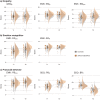A randomized controlled trial on the digital socio-emotional competence training Zirkus Empathico for preschoolers
- PMID: 37336872
- PMCID: PMC10279671
- DOI: 10.1038/s41539-023-00169-8
A randomized controlled trial on the digital socio-emotional competence training Zirkus Empathico for preschoolers
Abstract
In this randomized controlled trial (RCT), the digital socio-emotional competence training Zirkus Empathico was tested in 74 Central European children (5.1 (0.9) years; 34 females) within a longitudinal design (three time points: T1 = pre-training; T2 = immediately following 6-week training, T3 = 3-month follow-up). The pre-registered primary outcome was empathy, secondary outcomes included emotion recognition, prosocial behavior, and behavioral problem reduction; furthermore, children's neural sensitivity to facial expressions quantified with event-related potentials. Compared to controls (N = 38), Zirkus Empathico participants (N = 36) showed increases in empathy (d = 0.28 [-0.17, 0.76]), emotion recognition (d = 0.57 [0.01, 1.06]), prosocial behavior (d = 0.51 [0.05, 0.99]) and reduced behavioral problems (d = 0.54 [0.08, 1.03]). They also showed larger P3 amplitudes to happy vs. angry and neutral facial expressions post-training. Thus, Zirkus Empathico may be a promising digital training for social competence in preschoolers.
© 2023. The Author(s).
Conflict of interest statement
The authors declare no competing interests.
Figures






Similar articles
-
Fostering socio-emotional competencies in children on the autism spectrum using a parent-assisted serious game: A multicenter randomized controlled trial.Behav Res Ther. 2022 May;152:104068. doi: 10.1016/j.brat.2022.104068. Epub 2022 Mar 5. Behav Res Ther. 2022. PMID: 35364333 Clinical Trial.
-
Preschoolers' Sensitivity to Negative and Positive Emotional Facial Expressions: An ERP Study.Front Psychol. 2022 May 31;13:828066. doi: 10.3389/fpsyg.2022.828066. eCollection 2022. Front Psychol. 2022. PMID: 35712205 Free PMC article.
-
Harnessing Placebo Effects in Primary Care: Using the Person-Based Approach to Develop an Online Intervention to Enhance Practitioners' Communication of Clinical Empathy and Realistic Optimism During Consultations.Front Pain Res (Lausanne). 2021 Aug 24;2:721222. doi: 10.3389/fpain.2021.721222. eCollection 2021. Front Pain Res (Lausanne). 2021. PMID: 35295512 Free PMC article.
-
Empathy, emotional contagion, and rapid facial reactions to angry and happy facial expressions.Psych J. 2012 Dec;1(2):118-27. doi: 10.1002/pchj.4. Epub 2012 Aug 12. Psych J. 2012. PMID: 26272762
-
Current status of the anger superiority hypothesis: A meta-analytic review of N2pc studies.Psychophysiology. 2021 Jan;58(1):e13700. doi: 10.1111/psyp.13700. Epub 2020 Oct 11. Psychophysiology. 2021. PMID: 33040366 Review.
Cited by
-
Effectiveness of the ELLA Training for the Promotion of Emotional and Social Competences in Lithuanian Preschool Children.Int J Environ Res Public Health. 2022 Sep 26;19(19):12195. doi: 10.3390/ijerph191912195. Int J Environ Res Public Health. 2022. PMID: 36231494 Free PMC article.
-
Relationship between parenting stress and behavioral and emotional problems in preschool children: A mediation effect analysis.World J Psychiatry. 2025 Jan 19;15(1):100068. doi: 10.5498/wjp.v15.i1.100068. eCollection 2025 Jan 19. World J Psychiatry. 2025. PMID: 39831023 Free PMC article.
-
Stakeholder acceptance of a robot-assisted social training scenario for autistic children compared to a tablet-computer-based approach.Sci Rep. 2025 Apr 2;15(1):11237. doi: 10.1038/s41598-025-93970-x. Sci Rep. 2025. PMID: 40175476 Free PMC article.
-
Enhanced neural sensitivity to brief changes of happy over angry facial expressions in preschoolers: A fast periodic visual stimulation study.Psychophysiology. 2025 Jan;62(1):e14725. doi: 10.1111/psyp.14725. Epub 2024 Nov 18. Psychophysiology. 2025. PMID: 39558668 Free PMC article.
References
-
- Holodynski, M. & Rüth, J.-E. Emotionale Kompetenz. In Psychologische Förder- und Interventionsprogramme für das Kindes- und Jugendalter (eds Lohaus, A. & Domsch, H.) 2nd edn, 241–257 (Springer-Verlag GmbH, 2021).
-
- Decety, J. & Lamm, C. in The Social Neuroscience of Empathy 199–214 (2009).
LinkOut - more resources
Full Text Sources
Medical

